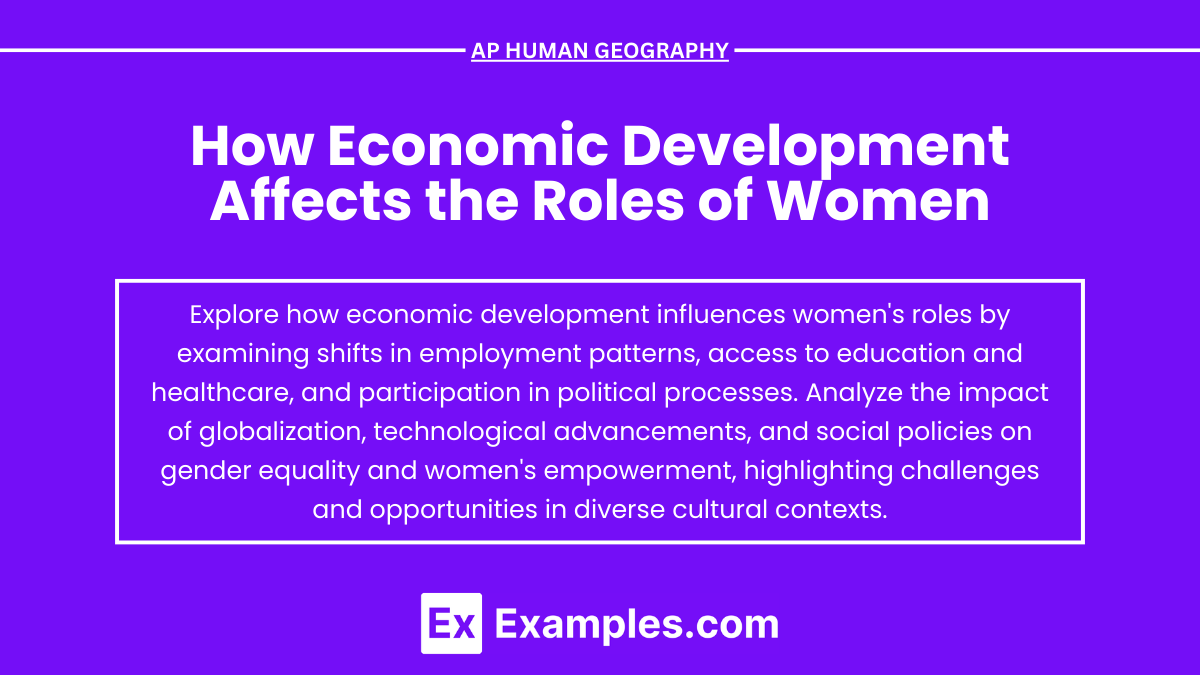Economic development significantly impacts the roles of women by reshaping their societal, economic, and political participation. As countries advance economically, women gain greater access to education, employment, and decision-making roles, fostering gender equality. In AP Human Geography, understanding this transformation is essential, as it highlights how modernization affects cultural norms and gender dynamics. Economic growth empowers women by increasing their autonomy and economic independence, though challenges remain in ensuring equal opportunities for all women, especially in less developed regions.
Learning Objectives
In studying how economic development affects the roles of women for AP Human Geography, you should learn how economic modernization reshapes gender dynamics, increasing women’s access to education, formal employment, and political participation. Understand how development reduces fertility rates, enhances women’s autonomy, and shifts cultural norms toward gender equality. Additionally, explore the challenges women face in achieving equal pay, leadership roles, and legal rights despite economic progress. Focus on how economic disparities can persist for women in rural and lower-income areas, requiring targeted gender policies.
How Economic Development Affects the Roles of Women
Economic development significantly influences the roles of women in society, altering their status, labor participation, and social dynamics across different regions and sectors. As countries transition from agricultural-based economies to industrial and service-oriented economies, the opportunities and challenges for women change accordingly.
1. Shift in Employment Opportunities
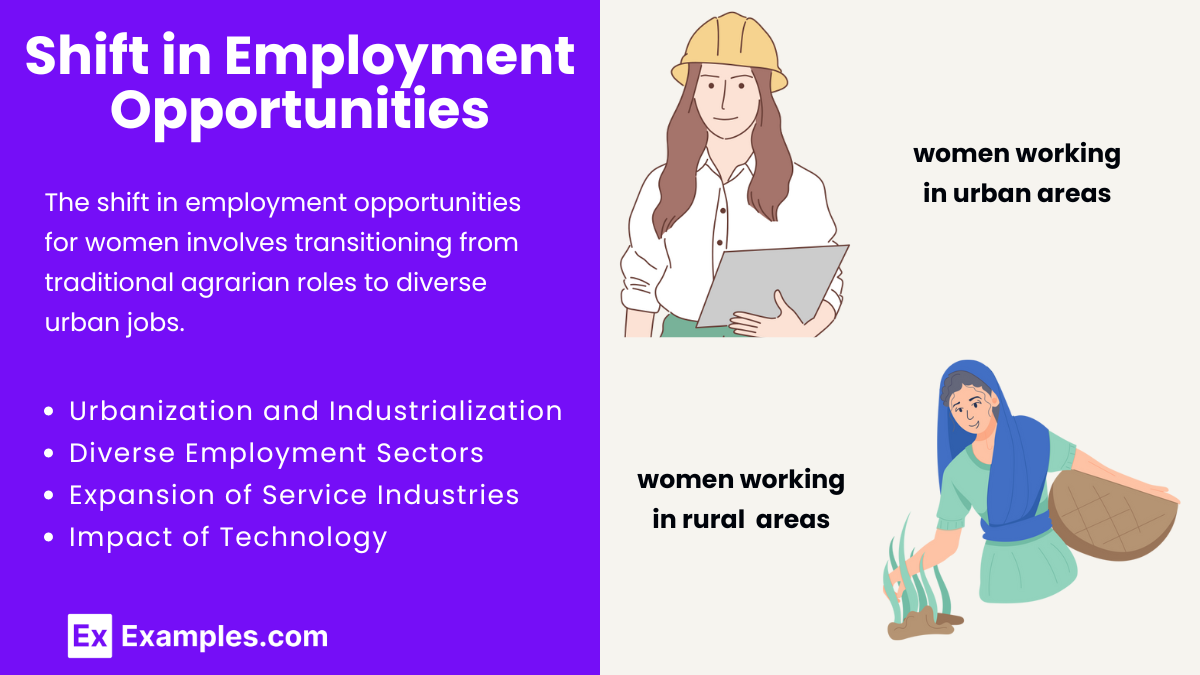
The shift in employment opportunities for women refers to the transition from traditional roles in agrarian societies to diverse job options in urban and industrial settings. This transformation is largely driven by economic development, urbanization, and industrialization, which create new avenues for women to engage in the workforce.
1.Urbanization and Industrialization
- Economic development spurs urbanization, leading to increased employment opportunities in urban centers.
- Industrialization shifts labor demand from agriculture to manufacturing and services.
2.Diverse Employment Sectors
- Growth in formal sectors (e.g., manufacturing, technology, services) provides varied job options for women.
- Traditional roles in agrarian societies are transformed as women enter the workforce.
3. Expansion of Service Industries
- The rise of service sectors like healthcare, education, and retail creates job opportunities specifically for women.
- These sectors often offer flexible work arrangements, appealing to women balancing family and work.
4. Impact of Technology
- Technological advancements in agriculture reduce the need for labor, allowing women to pursue other opportunities.
- Access to technology in domestic spheres increases efficiency, freeing up time for education and employment.
2. Impact on Gender Equality and Education

Economic growth generally correlates with improvements in education systems, particularly for girls and women. As economies develop, governments and international organizations invest in improving access to education, healthcare, and social services for women. Higher education levels provide women with the qualifications needed for skilled labor markets, enabling them to seek better jobs, higher wages, and leadership positions.
In many cases, economic development leads to a reduction in the traditional gender gap. For instance, as women gain financial independence, they can challenge existing gender norms and negotiate more equitable roles within households. Improved education also empowers women to advocate for legal rights, access to healthcare, and reproductive choices.
3. Changes in Family Structure and Fertility Rates
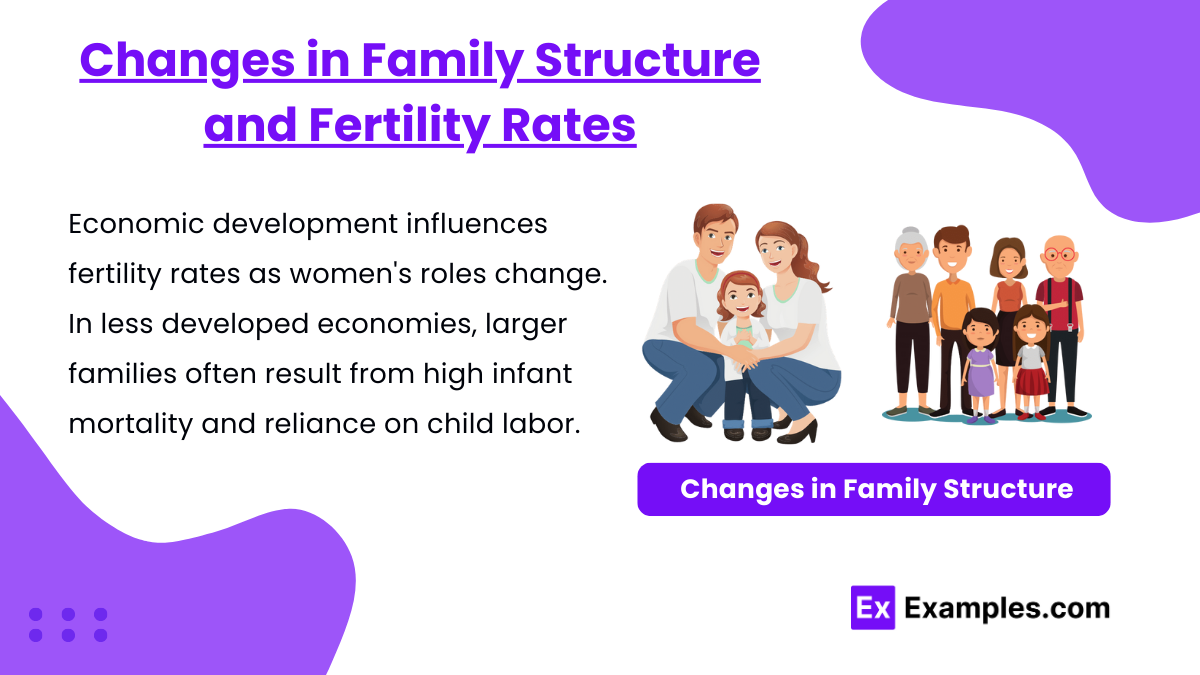
Economic development tends to influence fertility rates as women’s roles in society evolve. In less developed economies, women may have larger families due to higher infant mortality rates, lack of access to birth control, and reliance on children for labor. However, as economies develop, women typically have fewer children, partly due to greater access to healthcare and education. This demographic shift, known as the fertility transition, occurs as women delay marriage and childbirth to pursue education and careers.
As women participate more in the workforce, traditional family structures evolve. The role of women as primary caregivers may be supplemented by public services, such as daycare or family leave policies. These changes also influence men’s roles in the family, as dual-income households become more common, leading to more balanced gender roles in child-rearing and household responsibilities.
4. Challenges and Regional Disparities
Despite the overall positive correlation between economic development and gender equality, disparities remain between regions and sectors. In many developing countries, women still face barriers such as cultural norms, discriminatory laws, and unequal access to resources. For example, in rural areas, women may remain confined to informal or subsistence sectors, with limited access to formal employment or education.
In regions with high levels of economic inequality, the benefits of development are often unequally distributed. Wealthier women may have access to the best educational and employment opportunities, while poor women may continue to face exploitation, particularly in low-wage industries such as garment factories, domestic work, or agriculture. Additionally, some countries may experience a “feminization of poverty,” where economic growth benefits men more than women, leaving women disproportionately affected by poverty.
5. Political and Social Empowerment
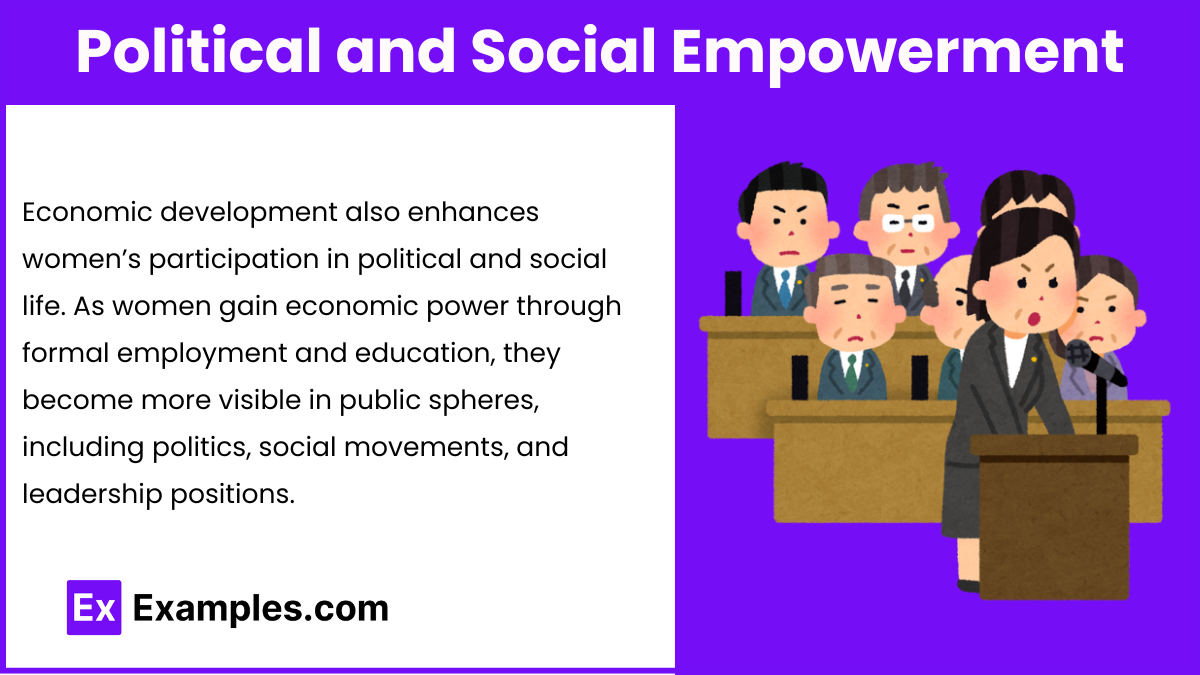
Economic development also enhances women’s participation in political and social life. As women gain economic power through formal employment and education, they become more visible in public spheres, including politics, social movements, and leadership positions. In developed nations, women are more likely to hold positions in government, business, and international organizations, advocating for policies that promote gender equality and women’s rights.
In some cases, development programs target women specifically, recognizing their role as key contributors to economic growth. Microfinance initiatives, for example, often prioritize women as recipients of small loans, enabling them to start businesses, gain financial independence, and reinvest in their communities. These programs can have a multiplier effect, benefiting not only women but their families and broader society.
6. Globalization and Women’s Roles
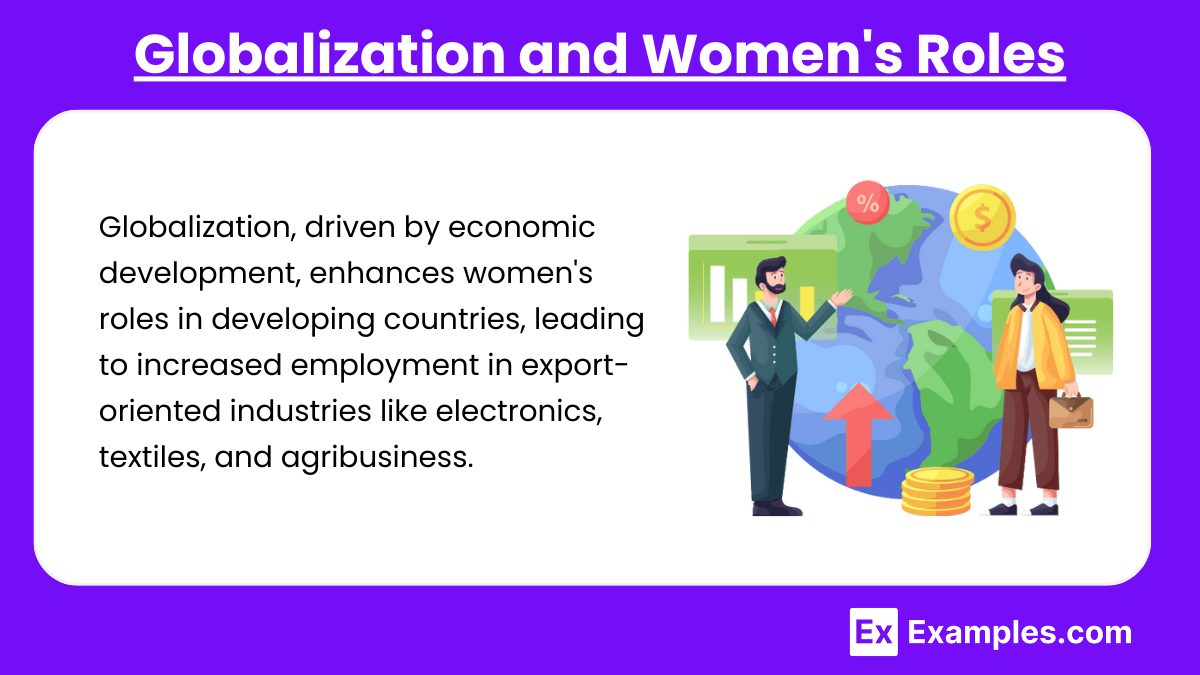
Globalization, a byproduct of economic development, also influences the roles of women. As global supply chains expand, women in developing countries are increasingly employed in export-oriented industries, such as electronics, textiles, and agribusiness. While this creates opportunities for income generation, these jobs are often characterized by poor working conditions, low wages, and limited job security.
Examples
Example 1: Education and Literacy in South Korea
South Korea’s rapid economic development from the 1960s onwards transformed the education sector. As the economy shifted from agriculture to manufacturing and technology, investment in education skyrocketed. Women, who were traditionally confined to domestic roles, increasingly gained access to higher education. Today, South Korea boasts one of the highest female literacy rates globally, with women playing key roles in fields such as education, healthcare, and business. The emphasis on education as a driver of economic development empowered women to take on professional roles, reshaping societal expectations.
Example 2: Employment Opportunities in Bangladesh
Bangladesh’s booming textile and garment industries have greatly impacted women’s employment. As economic development spurred industrial growth, women, especially from rural areas, moved into wage labor jobs in factories. This shift allowed women to move away from traditional agricultural and domestic roles, gaining financial independence and contributing significantly to household income. Despite challenging working conditions, the garment industry has offered millions of women economic mobility, challenging the country’s long-standing gender norms.
Example 3: Income and Financial Empowerment in Kenya
In Kenya, economic initiatives focused on entrepreneurship and microfinance have provided rural women with opportunities to start businesses. Programs offering small loans and business training to women enable them to participate in local economies by establishing farms, shops, and craft businesses. With their increased income, women invest in education for their children and improve their families’ living standards. This empowerment not only raises women’s social status but also helps foster broader economic development in rural communities, contributing to local and national growth.
Example 4: Political Participation in Rwanda
Rwanda’s post-genocide recovery and economic development emphasized gender equality as part of national rebuilding. As the economy developed, women were actively encouraged to participate in politics and governance. Today, Rwanda has the highest percentage of women in parliament globally, with women holding over 60% of parliamentary seats. Economic development combined with inclusive policies has allowed women to play pivotal roles in the country’s political landscape, advocating for policies on education, healthcare, and women’s rights.
Example 5: Healthcare and Family Planning in Brazil
Brazil’s economic growth throughout the late 20th century led to significant improvements in healthcare infrastructure, especially in urban areas. As the country developed economically, women gained access to better healthcare services, including reproductive health and family planning. This access allowed women to control the timing and size of their families, contributing to lower fertility rates. With smaller family sizes, women were able to focus on education and careers, increasing their presence in the workforce and altering traditional family dynamics in Brazilian society.
Multiple Choice Questions
Question 1
Which of the following is most likely to occur as a country experiences economic development?
A) Women’s participation in agricultural work decreases while their participation in the industrial and service sectors increases.
B) Women are more likely to work only in domestic roles and avoid formal employment.
C) Women’s participation in political leadership roles declines.
D) Women’s access to education decreases due to a focus on male education.
Correct Answer: A
Explanation: As a country undergoes economic development, industrialization and the growth of service sectors typically open up new employment opportunities for women. This shift often reduces their reliance on agricultural work, traditionally a domain of rural economies, and moves them into formal employment sectors like industry and services. These sectors offer more diverse job roles and can lead to economic independence. The other options are incorrect because economic development generally promotes gender equality in education (D), increases formal employment for women (B), and leads to greater political participation by women (C).
Question 2
How does economic development most commonly affect women’s fertility rates?
A) Fertility rates increase as women gain access to higher-paying jobs.
B) Fertility rates decrease as women gain access to education and employment opportunities.
C) Fertility rates remain unchanged, regardless of economic development.
D) Fertility rates increase as women enter the formal workforce in industrialized economies.
Correct Answer: B
Explanation: Economic development typically correlates with lower fertility rates for women. As women gain better access to education and employment, they are more likely to delay childbirth and have fewer children overall. Improved healthcare, family planning resources, and economic empowerment contribute to these lower fertility rates, allowing women to balance career and family more effectively. The incorrect options (A, C, D) either misunderstand the relationship between economic development and fertility or present scenarios that are less supported by the data on this issue.
Question 3
In the context of economic development, what is one significant factor that contributes to the political empowerment of women?
A) Decreased access to education as economic inequality widens.
B) Increased participation in informal, unpaid domestic work.
C) Higher literacy rates and educational achievements among women.
D) Reduced access to health care services.
Correct Answer: C
Explanation: Higher literacy rates and educational achievements are significant factors that contribute to women’s political empowerment as countries develop economically. Education equips women with the skills and knowledge necessary to engage in politics, advocate for their rights, and participate in leadership roles. The incorrect options (A, B, D) either incorrectly suggest that economic development decreases opportunities for women or focus on factors that are not typically associated with political empowerment.

